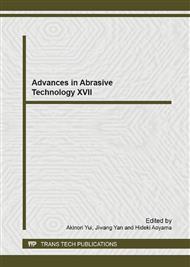p.709
p.715
p.720
p.726
p.735
p.741
p.747
p.753
p.758
Numerical Investigations on the Grinding Forces in Ultrasonic Assisted Grinding of SiC Ceramics by Using SPH Method
Abstract:
In this study, the grinding force variation mechanism in ultrasonic assisted grinding (UAG) of SiC ceramic is investigated by simulation method using a single diamond abrasive grain scratching. In simulation, the workpiece is modeled by smoothed particle hydrodynamic (SPH) method while the abrasive grain is modeled by finite element method (FEM). To reliably predict the grinding forces in UAG, an analytical model of average undeformed chip thickness ha is established. Grinding forces under different grinding parameters, i.e., depth of cut, and different ultrasonic vibration amplitudes are calculated by setting average undeformed chip thickness ha as scratching depth during SPH simulation process. The simulation results indicate that the normal force in UAG is reduced by about 20%, while the tangential force decreases up to 30% compared with those in conventional grinding (CG). The influences of grinding parameters and ultrasonic vibration on grinding forces will be investigated and the preliminary explanations will be presented.
Info:
Periodical:
Pages:
735-740
Citation:
Online since:
September 2014
Authors:
Price:
Сopyright:
© 2014 Trans Tech Publications Ltd. All Rights Reserved
Share:
Citation:


